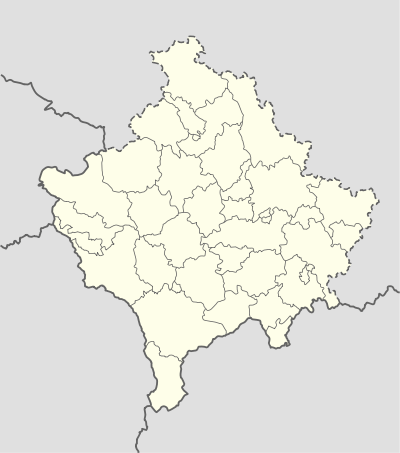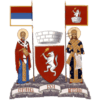Brezovica, Kosovo
| Brezovica Brezovicë/Брезовица | |
|---|---|
| Settlement | |
|
Brezovica Ski Resort | |
 Brezovica Location in Kosovo | |
| Coordinates: 42°13′19″N 21°00′17″E / 42.22194°N 21.00472°ECoordinates: 42°13′19″N 21°00′17″E / 42.22194°N 21.00472°E | |
| Country | Kosovo[lower-alpha 1] |
| District | Ferizaj |
| Municipality | Štrpce |
| Area | |
| • Total | 80 km2 (30 sq mi) |
| Elevation | 1,015 m (3,330 ft) |
| Population (2011)[1] | |
| • Total | 68 |
| • Density | 0.85/km2 (2.2/sq mi) |
| Time zone | CET (UTC+1) |
| • Summer (DST) | CEST (UTC+2) |
| Postal code | 38157 |
| Area code(s) | +381 290 |
| Car plates | 05 |
Brezovica (Serbian Cyrillic: Брезовица, Albanian: Brezovicë) is a settlement in the Štrpce municipality in Kosovo,[lower-alpha 1] known for its ski resort. According to the 2011 Census in Kosovo, Brezovica's total population is 68.[1]
Brezovica is the most visited winter tourist destinations in Kosovo. The ski resort area is ideally situated on the north and northwest-facing slopes of the Šar National Park. The ridge line spans 39,000 hectares of high alpine mountain terrain and forests, with a highly diverse and abundant flora and fauna. Located within 90 minutes of two international airports, the Brezovica resort area represents one of the last remaining under-developed ski resort areas in Southeast Europe.
Geography
It is situated in the northeastern part of the Šar Mountains, and in the drainage basin of the Lepenac river. The Brezovica ski resort is situated between 900 m and 2,500 m above sea level, about 14km south of the village. There is a combination of mild valley climate in the lower parts and Alpine climate in the higher regions.
History
In Medieval Serbia, the župa (province) of Sirinić (first mentioned in a charter of the 13th century, the second time in 1331, in a charter of Emperor Stephen Dušan) existed, covering the whole of modern Štrpce municipality, having the cities of Gradište (in Brezovica) and Zidinac (in Gotovuša). Several remains of Byzantine forts exist in the region.[2]
At the top of the Čajlije hill, above the mouth of the Piljevac creek of the Lepenac river, there exists the remains of the Gradište fort, which has two layers, the first from the 6th century,[2] and the second from the 13th century.[3] The fort is in ruins, of which a donjon tower, and outlines of other buildings, can be identified. The entrance to the city, at the north, was protected by a tower. From that tower, a rampart continued, with another tower, from where a defensive wall stretched to the foot of the hill, towards the Lepenac.[3]
On 28 June 1944, during World War II, Bulgarian soldiers executed 46 locals (of whom 12 were children) at Rakanovac, in Brezovica, after the death of one of their soldiers.[4]
Ski resort
The local ski resort was established in 1954. The first of five ski lifts to the resort was installed in 1979. The resort features 16km of ski slopes located on the north and northeast facing slopes of the Sarr Nature Reserve in the Šar Mountains. The ski slopes have an average length of 4km and an average of 128 skiable days per year. The resort was host to a number of international skiing events in the 1980s and 1990s but has since been developed for tourism. The resort features 4 hotels with 700 beds in total.
Wide ski terrains of the Ski Centre Brezovica are made of a system that includes: 5 chair lifts and 5 ski lifts, connected with 16 km of ski slopes of the average length 3,000 meters. On Brezovica FIS slopes for slalom, giant slalom, downhill race and “Super G” simultaneously could ski 50,000 skiers.
The ski resort area is ideally situated on the north and northwest-facing slopes of the Šar National Park. The ridge line spans 39,000 hectares of high alpine mountain terrain and forests, with a highly diverse and abundant flora and fauna. Located within 90 minutes of two international airports, the Brezovica resort area represents one of the last remaining under-developed ski resort areas in Southeast Europe. Inside of this area are ski slopes with average length of about 4 km (2 mi) and an average of 38% flexibility, at the sea level of 1718 m. The station of the outline with the exit from the cable car, is at a height of 2212 m above sea level. Ski center Brezovica is open for skiing during the seasons, where in summer its surface is covered with snow, with a low exploitation possibility. Wide ski terrains of the Ski Centre Brezovica are made of a system that includes: five chair lifts and 5 ski lifts, connected with 16 km (10 mi) of ski slopes of the average length 3,000 meters. There are four hotels at Brezovica. Three new lifts opened in 2008. On Brezovica FIS slopes for slalom, giant slalom, downhill race and "Super G" simultaneously could ski 50,000 skiers. A number of successful national and international competitions are held at the resort, including the Belgrade-owned "Inex ski center Brezovica", among others. A number of Kosovo winter sport teams train at the resort. A major investment from MDP Consulting Compagnie des Alpes is expected to have a significant impact in the area concerning environmental issues.[5][6]
Although Brezovica served as an alternative site for downhill skiing events of the 1984 Sarajevo Winter Olympic Games and hosted a number of International Ski Federation events in the 1980s and 1990s, the current resort has not received meaningful investment for more than two decades. The ridge line's terrain offers an unmatched opportunity in the region for the development of an all-year mountain resort. In the winter, snow falls from mid-November through May, with an average of 128 skiable days. Summer eco-tourism opportunities include hiking, mountain biking, golf, and other outdoor recreational activities. Hiking paths can lead the visitors to the nearby lake of Livadicko/Gjoli.
The ski centre has around 700 beds in four hotels, while additional accommodation possibilities exist in independent hotels and private facilities. Hotel clients have free transportation and free access to ski lifts. Construction of private houses is booming in the area despite it being a natural park.[7]

Demographics
| Ethnic group | 1981[8] | 1991 |
|---|---|---|
| Serbs | 323 (98,48%) | |
| Others | 5 (1,53%) | |
| Total[9] | 328 | 445 |
Annotations
- 1 2 Kosovo is the subject of a territorial dispute between the Republic of Kosovo and the Republic of Serbia. The Republic of Kosovo unilaterally declared independence on 17 February 2008, but Serbia continues to claim it as part of its own sovereign territory. The two governments began to normalise relations in 2013, as part of the Brussels Agreement. Kosovo has received recognition as an independent state from 110 out of 193 United Nations member states.
References
- 1 2 "2011 Kosovo Census: Population by localities".
- 1 2 Rastko website, rastko.rs; accessed 4 December 2015.(Serbian)
- 1 2 SANU, National Center for Digitization, Cultural Monuments in Serbia: Ostaci tvrđave Gradište-Čajlije
- ↑ SANU, National Center for Digitization, Cultural Monuments in Serbia: Rakanovac, spomenicikulture.mi.sanu.ac.rs; accessed 4 December 2015.
- ↑ http://www.balkaninsight.com/en/article/french-company-signs-490-mn-investment-deal-for-brezovica-ski-resort
- ↑ http://www.nytimes.com/2016/02/28/travel/kosovo-ski-holidays.html?_r=0
- ↑ "Brezovica Ski Resort". viewkosova.com. Retrieved 2014-03-02.
- ↑ 1981 Census, Kosovo Archived March 17, 2012, at the Wayback Machine.
- ↑ Kosovo censuses 1948-1991
External links
- Official site of the Brezovica Ski Center
- Brezovica-Ski.com
- Kosovo Ski Holiday, 2016 NYTimes feature

